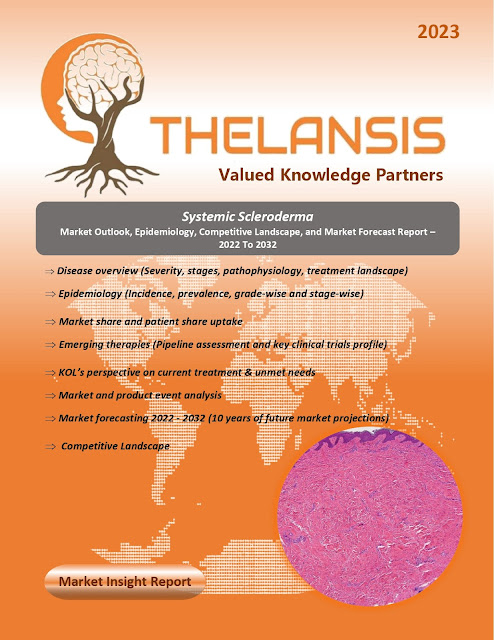Systemic Scleroderma – Market Outlook, Epidemiology, Competitive Landscape, and Market Forecast Report – 2022 To 2032
Scleroderma or Systemic sclerosis (SS), is a connective tissue disorder characterized primarily by the thickening and hardening of the skin. There are two primary types of scleroderma: localized and systemic. In localized scleroderma, the disease mainly affects the skin and may impact the muscles and bones. In systemic scleroderma, there is an involvement of the internal organs, such as the digestive tract, heart, lungs, and kidneys, among others. The severity and outcome of scleroderma are variable. Genetic and environmental factors play a role in the genesis of scleroderma. Silica and certain organic solvents are recognized as risk factors for the occurrence of systemic scleroderma. Life expectancy in patients with systemic sclerosis depends on the extent and severity of internal organ involvement. During SSc, the death rate is 3.5 times higher than healthy subjects of the same age. The overall survival of patients with SSc ranges from 75 to 80% after five years, 55% after ten years, 35 to 40% after 15 years and 25 to 30% after 20 years. Factors correlating with a higher risk of death are advanced age at diagnosis, male patients, diffuse skin involvement, and visceral involvement.
·
SSc's age and gender-adjusted incidence rates
were 15.1 per 100,000 people per year, with an adjusted prevalence of 25.9 per
100,000 people.
·
SSc-ILD had an adjusted incidence rate of 1.1
per 100,000 person-years and an adjusted prevalence of 7.3 per 100,000 people.
Thelansis’s “Systemic Scleroderma
Market Outlook, Epidemiology, Competitive Landscape, and Market Forecast Report
– 2022 To 2032" covers disease overview, epidemiology, drug utilization,
prescription share analysis, competitive landscape, clinical practice,
regulatory landscape, patient share, market uptake, market forecast, and key
market insights under the potential Systemic Scleroderma treatment modalities
options for eight major markets (USA, Germany, France, Italy, Spain, UK, Japan,
and China).
KOLs insights
of Systemic Scleroderma across 8 MM market from the centre of Excellence/
Public/ Private hospitals participated in the study. Insights around current
treatment landscape, epidemiology, clinical characteristics, future treatment
paradigm, and Unmet needs.
Systemic Scleroderma Market Forecast Patient
Based Forecast Model (MS. Excel Based Automated Dashboard), which Data Inputs
with sourcing, Market Event, and Product Event, Country specific Forecast
Model, Market uptake and patient share uptake, Attribute Analysis, Analog
Analysis, Disease burden, and pricing scenario, Summary, and Insights.
Thelansis Competitive Intelligence (CI) practice
has been established based on a deep understanding of the pharma/biotech
business environment to provide an optimized support system to all levels of
the decision-making process. It enables business leaders in forward-thinking
and proactive decision-making. Thelansis supports scientific and commercial
teams in seamless CI support by creating an AI/ ML-based technology-driven
platform that manages the data flow from primary and secondary sources.




Comments
Post a Comment